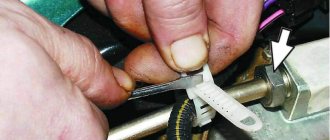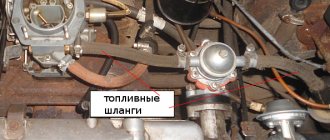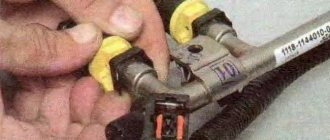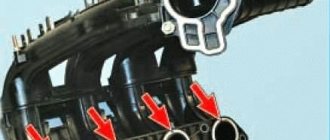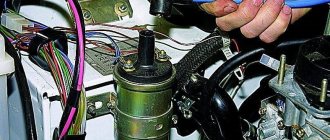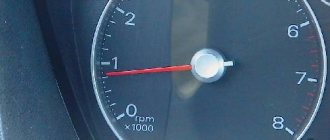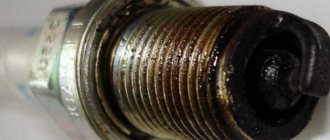The VAZ-2109 model with a carburetor engine is an unpretentious Russian car, characterized by a low price, economical fuel consumption, high maintainability, and very good technical characteristics. However, like any passenger car, it has its own characteristic “diseases”, one of them is that the engine starts and stalls, the carburetor overflows fuel. A similar malfunction occurs in various variants: the engine may stall while driving, the speed decreases when you press the gas pedal (and traction disappears), the engine stops when the car starts moving. Here we will try to consider all the main causes of the problem and the question of how such problems can be solved.
The main reasons for engine stopping while driving or after starting it
There are two main signs when an internal combustion engine (ICE) stalls:
- the motor stops almost immediately after starting (in place, without moving the car);
- the engine turns off (the speed drops to the very minimum) when you try to start moving or switch to a higher load.
The reasons for this behavior of the internal combustion engine are very different and sometimes unexpected; if the engine stalls, barely having time to start, this may be as a result of:
- lack of fuel supply (no gasoline entering the carburetor float chamber);
- somehow the ignition is turned off;
- idle speed disappeared;
- the fuel filter is clogged;
- a partition in the muffler blocked the exit of exhaust gases.
If there is no fuel supply, the fuel pump is most often to blame (on VAZ models 2108, 2109 and 21099 it is of a mechanical type).
To make sure there is fuel supply, you need to remove the central high-voltage wire, disconnect the main fuel pipe from the carburetor and crank it with the starter. If the used pump pumps, gasoline will immediately begin to flow out of the hose; this check should be carried out by two people.
Sometimes a situation arises when a partition inside the muffler blocks the outlet of exhaust gases, the engine “chokes” and does not work. When the exhaust is “half-covered,” the car simply drives poorly – sluggish acceleration, limited maximum speed. When the muffler pipe is completely blocked, the internal combustion engine starts and stalls almost instantly. Checking this version is quite easy:
- one of the diagnostic participants (also needs to be done together) starts the engine;
- the second person observes, placing his palm on the exhaust pipe, whether there is any exhaust of gases.
Another reason for the internal combustion engine to stop is the lack of idle speed in the carburetor; a similar defect is typical for front-wheel drive VAZs. At this point we will dwell in more detail and consider various options for the manifestation of the malfunction and ways to eliminate it.
The car starts and immediately stalls: causes and solutions to the problem
Owners of VAZ 2107, 2110, 2112, 2114, and other cars, may encounter a problem - the car starts and immediately stalls. The engine starts, but after a few seconds the speed drops and the engine stalls. Let's look at possible causes of startup failure and ways to eliminate them.
First, you need to go through the most obvious options.
- Gasoline (diesel fuel) has run out. No matter how paradoxical it may sound, drivers often forget to monitor the level of fuel in the tank.
- On diesel engines (especially in winter), the reason that the car starts and stalls almost immediately can be frozen fuel.
- The quality of gasoline at gas stations is often appalling, so if you fill your car with low-quality fuel, you may encounter the problem of a stalled engine. If there is only a little bad gasoline, you can dilute it with good gasoline. But if the tank is full, then it’s better to drain the surrogate out of harm’s way.
- Worn wires and old (faulty) spark plugs are also quite often the cause.
- Engine compression, or rather its absence, can provoke a situation in which the engine stalls barely having time to “catch up”. But this is already a very serious breakdown, the appearance of which is accompanied by a host of other symptoms, which are simply impossible not to notice during the operation of the car.
Problems with idle speed of VAZ models 2108-09-099
VAZ cars of the “ninth” family are equipped with Solex carburetors; they differ in modifications depending on the engine size (1100, 1300 or 1500 cm³). Externally, the carburetor units (CU) are almost completely identical, the difference lies in the internal “filling”: jets of different cross-sections, an accelerator pump nozzle (APA), emulsion tubes, and diffusers are installed. The idle speed system (IDS) in these CUs is responsible for the stability of minimum engine speeds, as well as for fuel consumption.
The Solex XX system includes the following elements:
- channels for supplying fuel and air;
- air jet;
- solenoid valve (EMV) with fuel jet;
- speed screw;
- adjusting needle for the quality of the fuel-air mixture.
The quantity screw sets the position of the throttle valve, leaving it slightly open, and the fuel mixture at low speeds, under the influence of vacuum, enters the engine through the carburetor and passes through the XX channels. Dosing of the mixture is ensured by jets, enrichment or combination is ensured by an adjusting needle, and the fuel supply is controlled using an EMG.
If the solenoid valve does not operate, or the channels are clogged, fuel and air in the required proportions will not flow into the intake manifold, idle speed will disappear. Because of this, various problems occur during the operation of the internal combustion engine:
- the engine starts and stalls because there is no idle speed;
- even if there is XX, the engine still works unstable, and when you try to start moving, it stops;
- the car loses dynamics, and when you press the gas, on the contrary, the car picks up speed.
If, with such signs, you unscrew the EMG a little, the engine will gain speed at idle, but this method will not solve the problem - the car will still not drive normally, and besides, fuel consumption will increase.
Finding the faulty component
So, what should you do if the engine starts easily, but then immediately slows down and stalls? The first thing you need to do is check for carbon deposits on the spark plugs. If some of them are covered with a layer of carbon deposits, then the engine a priori cannot operate normally. It first starts due to the movement of the starter, but immediately after that it brakes, since several cylinders are physically unable to withstand the entire load from the crankshaft. The carburetor, by the way, can also fail due to such a problem.
So what is the cause of engine failure? If the car starts, then at least the spark is fine. That is, the electrics work as expected. It wouldn’t hurt to unscrew the heads and try to find those spark plugs that are covered with a layer of soot. You can clean them by burning them over a gas burner and cleaning them with alcohol (this can only be done when the contacts are cold).
The injector itself may also become clogged. In this case, the fuel supply to the combustion chamber simply does not work. The following actions should be taken:
- remove the blocks and check the valves;
- check the operation of the sensors;
- check whether the engine operates normally at temperatures above 80ºС.
Naturally, the fuel pump itself can also fail. When the engine starts, the injector turns automatically due to the starter, and then the thrust comes from the generator. If one of these components is not working correctly, the car will simply stall. Here again we are talking about the residual amount of fuel in the cylinders. If the engine immediately stalls, and along with it the starter also works unevenly, then most likely the problem is either in it or in the ignition switch.
You should try to replace it with a known good one and retest the engine operation. As a last resort, the contacts are simply clamped.
What to do if idle speed disappears
If the car is unstable at idle, drives with dips, or constantly stalls, first of all you need to check the functionality of the solenoid valve. We check it as follows:
- we start the engine at low speed, and to prevent the engine from stalling, use the quality screw to add speed;
- with the internal combustion engine running, without pressing the gas pedal, pull off the EMG wire plug;
- if the nature of the work has not changed, you need to check the presence of power on the EMG; to do this, turn off the engine, turn on the ignition, and bring the chip with the wire to the valve. If there is voltage, a slight click should be heard (to hear it better, you can repeat the test several times).
If there is no power, most likely the economizer control unit has failed, or there is a bad contact somewhere in the wiring (probably a break). This problem needs to be fixed; it is possible that the reason for the absence of XX is hidden here.
But let’s say there is voltage on the valve, but the fault is still present. Now we need to check the operation of the valve itself, we perform this operation like this:
- remove the fuel jet from the EMG;
- We fix the valve body to the ground terminal of the battery, and apply plus to the EMG contact (you can also use it from the battery using a piece of wire);
- when the “plus” is applied, the solenoid valve needle should be retracted (triggered); if this does not happen, then the valve is faulty.
Complete sabotage
The most deplorable situation, the engine does not start at all.
First of all, you need to maintain composure and not scold the car itself. Only after this, we calmly begin to find out the reason why the engine does not start.
Do not allow the battery to be severely discharged by pointlessly rotating the engine crankshaft, the energy will still be useful to you, but where you will charge the battery if you are far from home is the question. Although for the electronic unit itself 8 Volts will be quite enough. But, of course, they won’t be enough for the starter.
When you have calmed down, be sure to check:
- How does the fuel pump work and is there any fuel in the tank?
- Is there ignition?
- Is the engine crankshaft timing sensor functioning?
- Have the injectors failed, although the failure of several injectors at once is too much, this happens very rarely.
- The ECU is working. But this device also fails very rarely.
Effect of air leaks in the fuel system
Unstable operation of the internal combustion engine, failures during acceleration of the car can also occur due to air leaks in the fuel system (TS), because as a result of the appearance of excess air mass, the proportion of the mixture necessary for the complete combustion of gasoline in the cylinders is disrupted. Air suction can occur:
- between the top cover and the main body of the carburetor due to metal deformation;
- due to a loose fit of the lower platform of the HRSG to the intake manifold;
- as a result of a rupture of the hose or its poor connection with the fittings of the vacuum brake booster (VUT);
- due to a malfunction of the vacuum booster itself.
It is quite easy to check whether VUT affects the stability of the engine; you need to disconnect the “vacuum” hose from the intake manifold, plug the fitting, and start the engine.
If, after installing the plug on the fitting, the engine operation is leveled out and it no longer “trips”, we have correctly identified the cause of the malfunction. Sure signs of leakage in such cases: a noticeable hiss of air in the area of the “vacuum chamber”, engine stopping or a sharp drop in speed after pressing the brake pedal. The power mode economizer (EMR) also affects the stability of the idle speed; more precisely, its diaphragm, if it is broken, the engine will not work normally at low speed. In any case, it is worth checking the condition of this part; you can remove the diaphragm without dismantling the carburetor (unscrew 3 screws).
Checking high voltage wires
When everything is in order with the ignition system, but the problem has not yet been solved, then the high-voltage wires are diagnosed. Under stable loads they can also fail.
As a rule, if the problem comes from the wiring, then the insulation or conductive parts in it are destroyed. Based on this, the electricity does not reach its destination and there is no spark. If the insulation is damaged, a breakdown occurs between the residential and vehicle ground. As a result, some of the electricity is lost, and this leads to a loss of spark power.
Checking the wires is carried out similarly to diagnosing spark plugs. Additionally, examine the wire resistance parameters. The range of acceptable values should be from 0.4 to 0.9 kOhm.
The influence of the accelerator pump on the operation of the VAZ-2109 internal combustion engine
Unstable engine operation, stalls, sluggish acceleration, etc. can also occur due to malfunctions in the Solex accelerator pump system. Here are the main causes of problems on the “nine”:
- incorrect dosage of the sprayer (“spout” or “elephant”), as well as clogging of this channel;
- torn or dried out diaphragm;
- incorrectly selected accelerator pump drive (“flag”).
Factory nozzles for the “nine” usually have two “spouts”, which are distributed among the chambers, but in the “secondary” fuel injection turns out to be completely unnecessary, at least that’s what many craftsmen think. The modernization of this part is the transfer of both “spouts” to the “primary chamber” (primary chamber), another option is the installation of a single sprayer from the KU for the Niva.
When bending the tubes, it is important to install them so that the injection passes exactly between the carburetor body and the damper, without hitting these parts, otherwise there will be no effect from such tuning.
The injection is checked, of course, with the carburetor removed, without the top cover, with the float chamber filled with gasoline. When you open the throttle (simulating pressing the gas pedal), you should get two even jets that pass through the lower part of the body without hitting it.
Carburetor power units are actually a thing of the past. But many cars on the roads of our country still use this option for supplying fuel to the engine. For many, a carburetor turns out to be a fairly convenient means of replacing an injector, since the car becomes easier to repair and cheaper to operate. In most cases, the owner of a carburetor car can independently carry out basic maintenance work on the fuel supply system. In the case of an injector, this task should only be performed by specialists. For simple carburetor repairs, you do not need special equipment, but to work with an injector, such devices are simply necessary. Therefore, such a part of the engine power system has certain advantages. Interestingly, these advantages force many to change the injector to a carburetor, which is not difficult at all.
Problems that arise with the carburetor can be very different. One of the common problems is that the engine stops working after the car has completely warmed up. The driver has to increase the speed with the help of a choke, but this trick will not work on carburetors with auto-choke. Eventually, the engine will stall as soon as you release the gas pedal. At every traffic light, intersection and pedestrian crossing, the driver begins to curse fate, red lights and innocent pedestrians, and the carburetor continues to stall and refuses to work normally, despite very expensive gasoline. Let's figure out the nature of this trouble.
Injector malfunction
The next reason that the engine starts and immediately stalls is a malfunction of the injector. Since most modern cars have a forced fuel injection system, this malfunction is very common.
Don't make mistakes.
What should not be allowed when operating fuel-injected cars:
- Do not disconnect the battery while the engine is running.
- Try to play with lighting as little as possible, and in general, handle food as carefully as possible. Injection cars are very sensitive to such manipulations.
- Try not to disconnect the ground on the car. Although I turn off the mains in my car in winter if I don’t drive for a long time, and so far I have not noticed any discomfort in operation, although many experts say that it is possible to erase information in the computer. I just try to let the car idle for up to 3 minutes when starting the engine.
- Injector-injected cars are not very fond of charging and starting devices, since when they are used, the voltage jumps significantly and the ECU can burn out.
ECU board.
- If a neutralizer is provided in the design of the car, then try not to start the car by towing or pushing it down a hill, as unburned fuel is formed, which, if it gets into the neutralizer, can ignite spontaneously.
- Do not allow water to enter the injector; this is strictly contraindicated. To do this, change fuel filters in a timely manner and fill with high-quality gasoline.
What does a neutralizer look like?
- If your car is equipped with an L probe and a neutralizer, then think about whether you should take the risk by using leaded gasoline. When using such gasoline, the L-probe, in addition to the fact that it itself can quickly break down, it will transmit incorrect data to the ECU, indicating a large amount of oxygen, and this, to put it mildly, is not very good, as it can lead to local overheating of the engine .
So, we return again to our problem, the engine starts and immediately stalls or does not start at all.
Why might the carburetor stall after warming up?
To understand the cause of this problem, it is best to contact motorists who have already encountered such a problem. Whatever happens to your car, remember that similar problems have most likely happened to other car owners. Therefore, you should visit specialized forums or simply chat with other motorists. In this case, you can find several options for answering your question. After warming up, the carburetor completely closes the choke valve, leaving the accelerator valve in working condition. If the idle speed is set incorrectly, the engine will only run on choke. But this is the basic reason; there are several other popular problems:
- rapid engine overheating and serious problems with the cooling system of your power unit;
- very poorly adjusted valves - adjustment has not been made for several years in a row;
- the carburetor is not adjusted, the mixture is too lean, the system blows too much air into the combustion chamber;
- the mixture can also be overly rich, which causes fuel overflow and problems in some carburetors;
- the carburetor jets are clogged, fuel flows poorly through them, which causes problems in the quality of the mixture;
- gasoline is incredibly bad, the filters are clogged, the flow rate of the fuel system has become much lower;
- Certain problems have arisen inside the carburetor, membranes and gaskets have broken, and fuel is leaking.
We carry out diagnostics and repair work on the carburetor ourselves
You can take advantage of excellent carburetor work if you know its design and have already dealt with simple repair processes. Otherwise, we do not recommend that you try recovery on your own. Ultimately, such repairs will cost much more than they could cost from specialists. If you have experience and confidence in your skills, you can use the advice of specialists to perform a high-quality restoration of your car. Among the main work that will have to be carried out, the following processes can be identified:
- remove the carburetor cover with the air filter and try to start the car, as it warms up, lower the choke and look at the position of the dampers, perhaps adjusting them will be enough to restore the car’s operation;
- if this does not help, look at the functioning of the fuel system; perhaps the fuel pump stops pumping fuel after a certain period of normal operation;
- also examine the cooling system, regardless of what the gauges on the dashboard say, look at the antifreeze level, make sure the thermostat is working correctly;
- you can also change the air and fuel filters to make sure that fuel and air enter the carburetor without problems and in sufficient quantities;
- the last stage of work is the removal and disassembly of the carburetor to install a repair kit, new gaskets, membranes and other parts, as well as to clean this device from contamination.
You can think for a long time about what the problem really is, or you can simply go to an automotive supply store, buy a carburetor repair kit that is installed under the hood of your car, carry out the necessary work and get the cleanest operation of the power unit. This is the only way you can get high-quality operation of the equipment and no problems with the power unit. After diagnostics and corrective work, the carburetor will definitely stop tormenting you with constant stoppage of operation. This will allow you to operate the car efficiently and safely.
Carburetor repair by specialists is the best solution
If you have a carbureted car, it would be best to find a professional who can service the equipment regularly. Your car will require high-quality maintenance on a regular basis, since the carburetor is constantly becoming clogged and presents more and more problems in operation. Therefore, it would be best to use the services of a specialist who knows his business very well and performs cleaning, regular maintenance and repair of carburetors, as well as all related equipment. The main criteria for choosing a specialist are as follows:
- experience in working with your car model, sufficient professionalism, confirmed by years of work;
- positive reviews from other owners of carburetor cars who received quality service;
- affordable prices - you don’t have to choose an expensive service station, you can cooperate with a private master;
- fairly quick completion of all necessary repair work, but the presence of a guarantee of the quality of the result;
- the possibility of ordering complex work with the purchase of spare parts performed by a specialist in order to relieve oneself of responsibility for the quality of parts;
- other convenient services, as well as the possibility of full vehicle maintenance.
It is convenient when all repairs and maintenance are carried out by one person. This makes it quite easy to get a high-quality working car, since one person or one company is responsible for it. If one person repairs your carburetor, another person maintains the car, and a third person solves problems with the generator, all this is not very convenient for repair work on the car. So it’s better to find a universal specialist and constantly service the car exclusively from him. If you have a Solex carburetor installed on your car, we suggest watching a video about its disassembly and maintenance:
Let's sum it up
Fine cars with carburetor engines have become industrial history, but they are still widely represented on the roads. That is why you can use the ideas presented in this publication, since there are still a lot of carburetor masters, and you can find the necessary spare parts in stores. If your car has problems with the quality of the fuel supply system, it’s time to fix all these problems. You can quite easily obtain high quality operation of the power unit and fuel system if you simply take care of all the important components of the car.
For the carburetor to work properly, it simply needs to be cleaned occasionally. This point is quite important for every car operating in Russia. Fuel quality, atmospheric pollution - all this affects the normal operation of the engine. It is enough to carry out a high-quality cleaning of the fuel supply system every few years by performing certain maintenance processes to ensure long-term and high-quality operation of all engine systems. How did you maintain a carburetor car?
